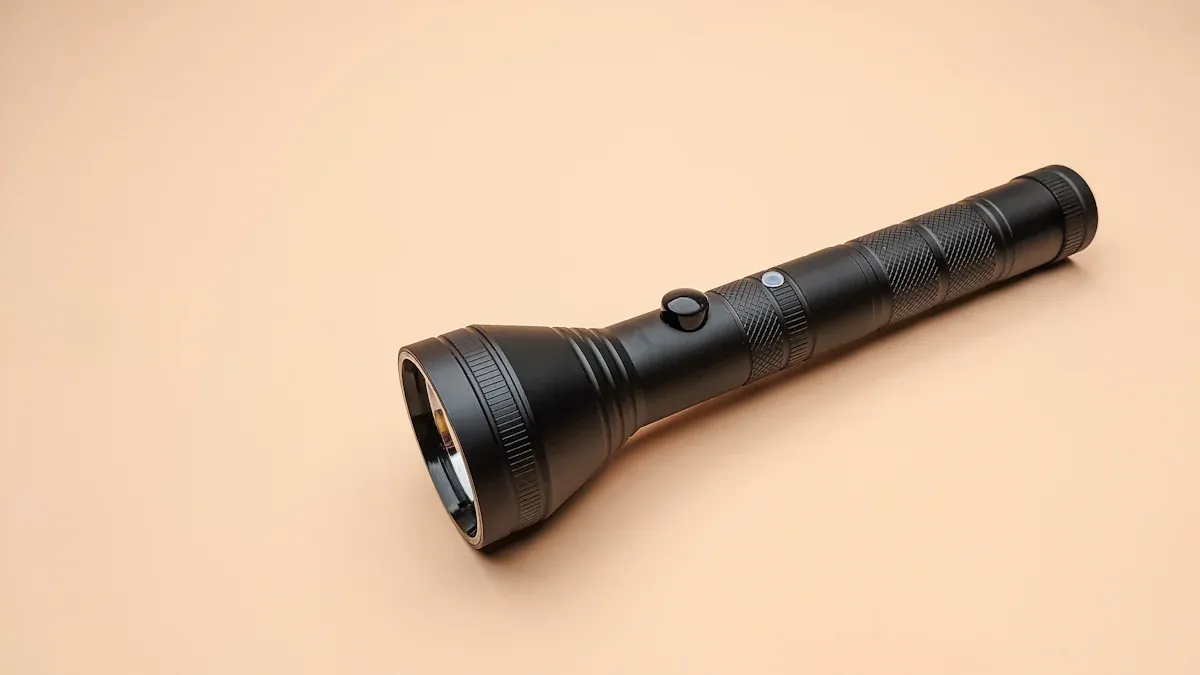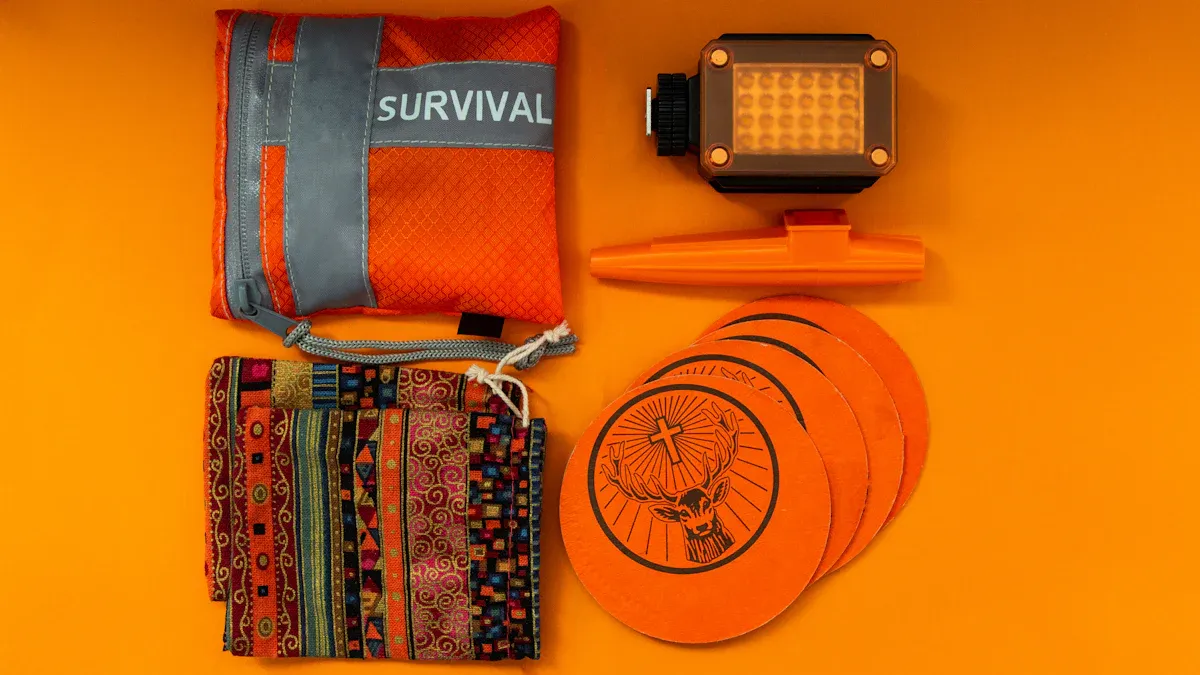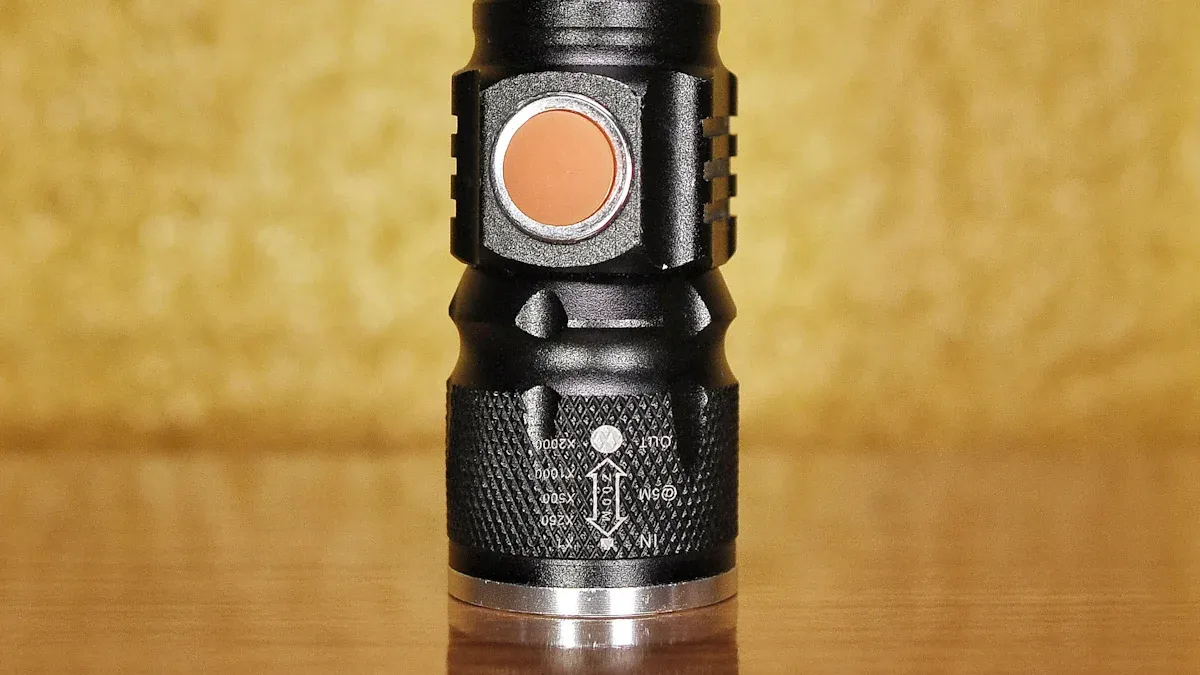Flashlights That Save Lives in Emergencies

In emergencies, a strobe flashlight can make the difference between chaos and control. Its flashing light grabs attention, helping you signal for help or locate lost items. Security professionals rely on strobe flashlights to disorient threats, ensuring personal safety. Emergency responders use them to enhance visibility near traffic, reducing risks. Even pet owners have used strobe lights to find lost animals at night. These versatile tools are indispensable for navigating hazardous situations and staying prepared.
Key Takeaways
Strobe flashlights are important for asking for help in emergencies. Their blinking light is easy to see, helping rescuers find you.
These flashlights can confuse dangers, giving you an edge in self-defense. The quick flashes make it hard for attackers to see clearly.
When picking a strobe flashlight, look for brightness, strength, and different settings. A good flashlight keeps you safer in sudden emergencies.
What is a Strobe Flashlight?
Definition and Features
A strobe flashlight is a specialized tool designed to emit rapid, pulsating bursts of light. Unlike standard flashlights, which provide a steady beam, strobe flashlights use a flashing pattern to grab attention or disorient threats. These devices are invaluable in emergencies, offering features that go beyond basic illumination.
You’ll find strobe flashlights equipped with high-lumen outputs, making them effective for both short-range and long-range visibility. Many models include adjustable brightness settings, allowing you to switch between steady light and strobe mode. Durability is another hallmark of these tools. Most strobe flashlights are built with rugged materials, ensuring they withstand harsh conditions. Some even come with water-resistant or shockproof designs, enhancing their reliability in critical situations.
Tip: When choosing a strobe flashlight, look for models with ergonomic designs. A comfortable grip can make a big difference during prolonged use.
How Strobe Mode Works
Strobe mode operates by rapidly cycling the flashlight’s light on and off. This creates a pulsating effect that is highly visible, even from a distance. The mechanism behind strobe mode involves a microcontroller inside the flashlight. This component regulates the intervals at which the light flashes, ensuring a consistent pattern.
In emergencies, strobe mode serves multiple purposes. It can signal for help, alerting rescuers to your location. It can also disorient potential threats, giving you a critical advantage in self-defense situations. The flashing light overwhelms the human eye, making it difficult for an aggressor to focus. Additionally, strobe mode conserves battery life compared to continuous light, making it a practical choice for extended use.
Note: Always familiarize yourself with your flashlight’s strobe mode settings. Quick access to this feature can be crucial in high-pressure situations.
Benefits of Strobe Flashlights in Emergencies

Signaling for Help
In emergencies, a strobe flashlight becomes a powerful tool for signaling your location. The flashing light grabs attention quickly, even in chaotic environments. Whether you’re stranded during a power outage or lost in the wilderness, strobe mode can act as a lifesaving beacon. Its pulsating pattern is highly visible, making it easier for rescuers to locate you. For example, hikers have used strobe flashlights to signal for help during nighttime rescue missions, ensuring their safety in critical situations.
Adding a strobe flashlight to your emergency kit enhances your preparedness. It ensures you have a reliable way to communicate distress signals when other methods, like phone calls, fail. The bright, flashing light cuts through darkness and adverse weather conditions, making it an essential tool for emergency preparedness.
Disorienting Threats
Strobe flashlights are not just for signaling; they also serve as tactical tools for self-defense. The rapid, pulsating light disorients potential threats by overwhelming their vision. This temporary confusion gives you valuable time to escape or call for help. Security professionals often rely on strobe mode to neutralize aggressors without physical confrontation.
For personal safety, a strobe flashlight is indispensable. Imagine walking to your car late at night and encountering a suspicious individual. Activating the strobe mode can deter the threat and provide you with a critical advantage. Its effectiveness lies in its ability to disrupt focus, making it harder for an aggressor to act.
Enhancing Visibility
Strobe flashlights significantly improve visibility in emergencies. Their bright, flashing beams cut through darkness, fog, and rain, ensuring you can navigate safely. Emergency responders use strobe lights to enhance visibility near traffic, reducing the risk of accidents. For instance, rotating strobe lights on emergency vehicles alert drivers, helping clear the way for faster response times.
Strobe flashlights also play a role in protecting vulnerable individuals. Schools for children with special needs use strobe lights to signal emergencies, benefiting students with hearing impairments. Similarly, shopping malls and homes have incorporated strobe lights into their security systems to deter intruders and enhance safety. Whether you’re dealing with a roadside emergency or a natural disaster, the enhanced visibility provided by strobe flashlights can save lives.
Tip: Choose the best flashlight with high-lumen output and durable construction to ensure optimal performance in emergencies.
Real-Life Scenarios for Strobe Flashlights

Natural Disasters
During natural disasters, reliable lighting becomes a lifeline. A strobe flashlight can help you navigate through power outages, signal for help, and maintain visibility in chaotic conditions. Whether you’re dealing with a hurricane, earthquake, or flood, the flashing light of a strobe mode cuts through darkness and debris, ensuring you stay visible to rescuers. Emergency preparedness experts recommend adding a tactical flashlight to your emergency kit. Its durable design and high-lumen output make it a dependable tool in extreme weather conditions.
For example, during hurricanes, strobe flashlights have been used to guide families to safety through flooded streets. Their ability to function in adverse weather makes them indispensable. You can also use them to mark your location, ensuring rescuers spot you quickly. A strobe flashlight is not just a tool; it’s a lifesaver in unpredictable situations.
Personal Safety and Self-Defense
A strobe flashlight is a powerful tool for personal safety. Its strobe mode can disorient potential threats, giving you time to escape or call for help. The rapid flashing light overwhelms an attacker’s vision, making it difficult for them to focus. Security professionals often rely on tactical flashlights for this reason. You can carry one for self-defense, especially in poorly lit areas.
Strobe flashlights can temporarily blind an attacker, enhancing your safety.
The best strobe frequencies (18 Hz to 20 Hz) are particularly effective in disorienting threats.
A flashlight designed for self-defense should be bright, portable, and durable, with an easy-to-use strobe function.
Imagine walking alone at night and encountering a suspicious individual. Activating the strobe mode can deter them, giving you a critical advantage. A tactical flashlight is not just a source of light; it’s a tool that empowers you to protect yourself.
Roadside Emergencies
Roadside emergencies often occur in low-light conditions, making visibility crucial. A strobe flashlight serves as both a tool for inspection and a distress signal. For instance, if your car breaks down on a deserted road, you can use the flashlight to check under the hood. The strobe feature can then attract attention from passing vehicles, ensuring you receive help quickly.
A motorist once used a strobe flashlight to signal for help after a breakdown. The flashing light caught the attention of a passing driver, who stopped to assist.
Strobe flashlights are also effective in marking your location during nighttime roadside emergencies, reducing the risk of accidents.
Adding a strobe flashlight to your emergency kit ensures you’re prepared for such situations. Its dual role as a lighting tool and a signaling device makes it an essential companion for drivers. Choose the best flashlight with a durable design and high-lumen output to ensure it performs reliably when you need it most.
Choosing the Best Strobe Flashlight
Key Features to Consider
Selecting the right strobe flashlight involves evaluating several critical features. These features ensure the flashlight performs effectively during emergencies and enhances your safety. Here are the most important aspects to consider:
Brightness: A flashlight with high lumens output (preferably over 1000 lumens) ensures maximum visibility in low-light conditions. Brightness is crucial for signaling and illuminating large areas.
Runtime: A longer battery life allows extended use during emergencies. Look for models with efficient power management to avoid running out of light when you need it most.
Durability: Choose a flashlight made from sturdy materials like aluminum or reinforced plastic. Weatherproofing and shock resistance are essential for outdoor use.
Versatility: Flashlights with multiple modes, including strobe mode and SOS mode, provide flexibility for different scenarios. Adjustable beam types, such as flood or spot, enhance usability.
Tip: Flash patterns with faster strobe speeds are more effective for disorienting threats, while slower patterns work better for signaling.
Additional considerations include beam distance, ergonomic design, and portability. A compact flashlight is easier to carry, making it an essential item for your emergency kit.
Recommended Flashlight Types
When choosing a strobe flashlight, consider models designed for specific purposes. Tactical flashlights, for example, are ideal for self-defense and emergency preparedness. These flashlights often feature high-lumen outputs, durable construction, and quick-access strobe mode settings.
For outdoor enthusiasts, survival flashlights offer rugged designs and extended runtimes. These models often include water-resistant features and multiple light modes, making them suitable for camping, hiking, or natural disasters.
If you need a flashlight for roadside emergencies, opt for one with a magnetic base or a built-in hook. These features allow hands-free use, making it easier to inspect your vehicle or signal for help.
Note: Always test your flashlight before adding it to your emergency kit. Ensure it functions reliably and meets your specific needs.
By prioritizing these features and types, you can select a strobe flashlight that provides high visibility, enhances safety, and serves as a dependable tool in critical situations.
Strobe flashlights are indispensable tools for ensuring safety in darkness and emergencies. Their advanced features, such as high-intensity light and rapid flashing, enhance visibility and grab attention in critical moments. Investing in a high-quality flashlight ensures reliability, thanks to advanced LED technology, versatile brightness modes, and extended runtime. These tools empower you to stay prepared and protect yourself effectively.
Tip: Choose a flashlight with emergency features like strobe or SOS signals to maximize your safety during unexpected situations.
FAQ
What makes a strobe flashlight different from a regular flashlight?
A strobe flashlight emits rapid, pulsating light bursts. This feature enhances visibility, signals for help, and disorients threats, unlike a regular flashlight's steady beam.
Tip: Always test the strobe mode before emergencies to ensure it functions as expected.
How do I maintain my strobe flashlight for emergencies?
Store it in a dry, accessible location.
Check batteries regularly.
Clean the lens and casing to ensure optimal performance.
Note: Replace batteries immediately if you notice dimming or inconsistent light output.
Can strobe flashlights harm your eyes?
Yes, prolonged exposure to strobe lights can strain or temporarily impair vision. Use strobe mode responsibly, especially around children or individuals with light sensitivity.
Caution: Avoid pointing the strobe light directly at someone's eyes unless necessary for self-defense.
See Also
Essential Hand-Cranked Flashlights for Emergency Preparedness
Why Rechargeable Flashlights Are Crucial for Community Safety
A Homeowner's Guide to Selecting the Right Emergency Flashlight
Top LED Flashlights Every Home Should Have for Convenience
Camping Essentials: Comparing Lanterns and Flashlights for Adventures
